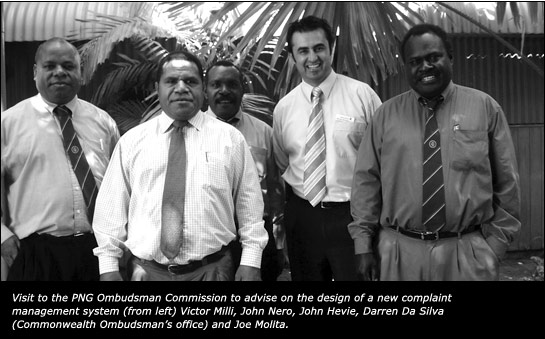Features | Celebrating thirty years | Commonwealth Ombudsman Annual Report 2006-07


Features
FEATURE 1 | celebrating thirty years
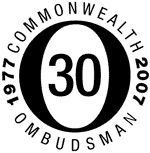 Not many public institutions survive thirty years with its core functions virtually unchanged. The Commonwealth Ombudsman reached that milestone on 1 July 2007.
Not many public institutions survive thirty years with its core functions virtually unchanged. The Commonwealth Ombudsman reached that milestone on 1 July 2007.
Over the past thirty years the Ombudsman has dealt with more than 600,000 complaints and has helped government agencies change the way they go about their business to provide a better public service.
Each year the Ombudsman investigates complaints about more than 100 Australian Government departments and agencies. Around three quarters of those complaints focus on five agencies with high volume public contact—Australia Post, the Australian Taxation Office, Centrelink, the Child Support Agency, and the Department of Immigration and Citizenship.
The Commonwealth Ombudsman was established with cross-party political support during a time of innovation in Australia’s federal justice system. Australia’s first Ombudsman, Prof. Jack Richardson, opened the Canberra office on 1 July 1977. Following Prof. Richardson there have been six Ombudsmen—Geoffrey Kolts, Prof. Dennis Pearce, Alan Cameron, Philippa Smith, Ron McLeod and currently Prof. John McMillan.
As an important independent arbiter in a system of government undergoing constant change, the responsibilities of the Commonwealth Ombudsman have expanded over thirty years to cover areas of specific expertise such as defence, immigration, law enforcement, taxation and the postal industry.
The office has dealt with nearly every kind of complaint made against government. We continue to work with agencies to address and prevent systemic problems and to improve public administration.
Through our past successes, and the demands of the future, the Commonwealth Ombudsman continues to work towards better connecting government and the public.
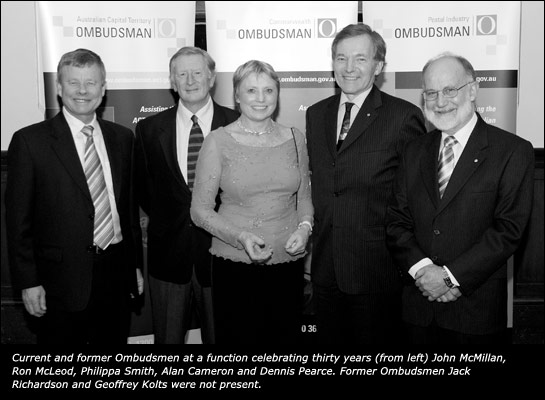
FEATURE 2 | from paper to an automated office
When the Ombudsman commenced operation in 1977, complaints were recorded on a single line in a large ledger, with details such as the complainant’s name, agency complained about and complaint subject. All related papers were placed on a file, and a notation made in the ledger when the complaint was finalised.
In 1983–84 an Automatic Data Processing Strategic Plan was approved. By the end of 1985, the office had acquired ‘some’ microcomputers for the Canberra office, networked to a ‘CT Megaframe’. One microcomputer was for word processing purposes and the other for software development and system testing.
By 1986, the central office was able to use the computer system to record all complaints, track complaint processing, report on outstanding matters and provide some statistics on workflow. It was not until 1989 that all of the Ombudsman’s offices had computers and were able to enter complaints into a database rather than a ledger.
The complaint management systems used in the office have been updated many times since 1989, recognising that automated systems should reflect the changing world around them and the changing needs of users.
Today’s sophisticated complaint management system, Resolve, not only contains basic data relating to a complaint, but also holds electronic copies of most documents and cross-references to related matters. It has an automated workflow—pre-programmed steps that lead the investigation officer through the complaint process—and automatically sends a reminder if an action is overdue. Statistics can be generated about specific types of complaints, complaints about a particular agency, all complaints from an individual, or all complaints allocated to a particular investigation officer.
Staff no longer need to trawl through stacks of paper to find answers—information retrieval is possible with a few keystrokes and a click of the mouse. Finding information is much simpler, enabling the Ombudsman to more easily detect systemic issues and related complaints.

FEATURE 3 | continuing a national operation
The Commonwealth Ombudsman is one of the few national ombudsmen established in a federal system of government. The office covers perhaps the largest geographic area of any ombudsman. This poses challenges in handling complaints about government on a national basis. At the same time, there are benefits to be gained from the national character of the office.
From a staff of five in 1977 to a staff of 146 in 2007, the Commonwealth Ombudsman’s office continues with a national structure and complaint-handling operation, by maintaining offices in capital cities throughout Australia.
The Ombudsman’s eight different offices function as part of a unified national office in various ways. One of the ways national integration of the work of the office is achieved is through the complaint management system that is used to record, search and retrieve complaint information. The system enables complaint records to be transferred efficiently within the state offices as well as from one state office to another, or to a specialist team in Canberra.
The main agencies about which we receive complaints have a diversified national structure similar to our own. Complaint handling operates more smoothly if there is a good working relationship between the Ombudsman’s office and the relevant government agency. This working relationship is promoted at the local level with regular meetings being held with agency complaint-handling staff to improve communication and cooperation, and to discuss complaint issues and trends.
Problems people encounter with government are not necessarily the same on a national basis. There can be regional differences: problems experienced in an office in one state are not always the same in another. Our national structure, and our close cooperative relationship with the state and industry Ombudsman offices, enables us to continue to provide an efficient and effective complaint-handling service to the general public and government.
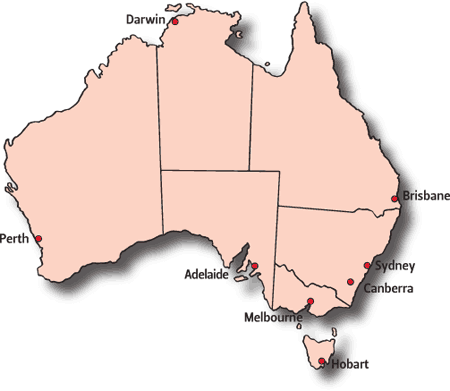
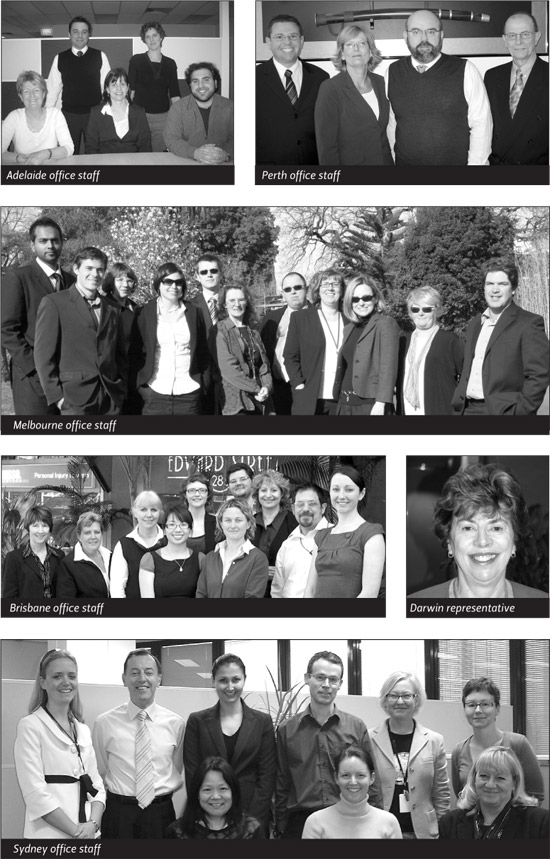
FEATURE 4 | publishing the ombudsman's investigations
An early amendment to the Ombudsman Act in 1983 gave authority to the Ombudsman to release information in the public interest (s 35A). Some other Ombudsman offices in Australia can only release the results of an investigation by making a report to the Parliament.
The Commonwealth Ombudsman has used this power many times to publish investigation reports. The current practice of the office is to publish, either in full or in abridged form, any formal report by the Ombudsman to an agency that contains a finding of administrative deficiency. Reports are made available on the Ombudsman website.
Some published reports arose from the investigation of individual complaints or incidents—for example, the failure of an agency to provide adequate reasons, police handling of a demonstration, a government tender process, or an Australian Defence Force accident. Many other reports arose from own motion investigations undertaken by the Ombudsman into general administrative problems or systemic difficulties in agencies. Examples are reports into complaint handling in agencies, freedom of information administration, whistleblower protection, child support assessment, tax minimisation schemes, and family tax benefit.
Certain issues have cropped up on a regular basis and been reported on several times. These include immigration detention, contracting out of government services, and the use of entry, search and seizure powers.
The use of entry, search and seizure powers by agencies attracts special interest because of the difficult balance to be struck in administering and enforcing the law. Coercive powers are commonly given by legislation to government agencies so that they may ensure community compliance with the law. In doing so, the agencies should pay proper regard to the rights and privacy of people. Whether that occurs can be a fertile source of complaints to the Ombudsman.
Immigration-related issues are another common topic in Ombudsman reports, because of the sensitive issues that arise in immigration administration. Issues canvassed in published reports include the management of immigration detention centres, visa processing, compliance operations, and the supporting role played by state police and state correctional facilities.
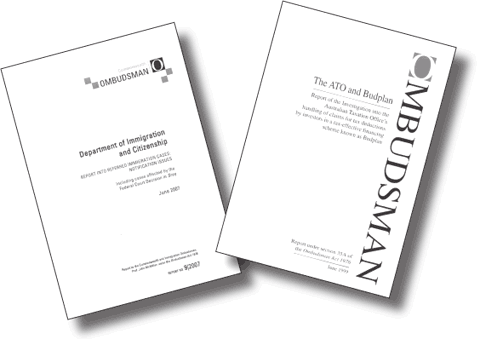
FEATURE 5 | common issues
The same issue can crop up in different agencies at different times. Over the past ten years the Ombudsman has reviewed the complaint-handling processes of Australia Post; the Australian Broadcasting Authority; the Australian Broadcasting Corporation; the Australian Federal Police; Australian Taxation Office; Centrelink; Child Support Agency; Department of Employment, Workplace Relations and Small Business; Department of Health and Aged Care; Job Network; Migration Agents Registration Authority; National Gallery of Australia; and complaint handling in airports.
We identified deficiencies in complaint-handling processes and procedures and made recommendations to improve them. This included better training for staff who deal with complaints, improving complaint forms to make them more easily understandable, and reviewing complaint management and quality assurance mechanisms.
The importance of managing and dealing with complaints from clients has been recognised by government. All agencies now have a service charter and many have dedicated complaint-handling units.
Problems stemming from inaccurate advice and unrecorded oral advice is another issue that has arisen in multiple agencies and been reported on by the Ombudsman.
People rely on oral advice from government agencies and expect that a record will be kept by the agency. Many people do not realise that if they don’t ask the right question, they may not get the answer they need. When people rely on the advice given and it proves to be incorrect or inaccurate for their circumstances, they may experience financial loss. If there is no record to back up their assertion as to the advice given, they will face difficulty in obtaining a refund or appropriate compensation.
The Ombudsman has also publicly released three reports on the administration of the Freedom of Information Act 1982 by government agencies. The reports raised concerns about how agencies handled FOI requests, and stressed the importance of agencies demonstrating their commitment to FOI.

FEATURE 6 | promoting our services
 The office’s advertising and marketing activities of 2007 are a long way from those of the early days, when the office was promoted through a small number of radio and newspaper ads
and the Ombudsman appearing on three television programs—Four Corners, Willesee at Seven, and The Mike Walsh Show. The first pamphlet setting out what the Ombudsman does and how to complain was released in June 1978, and was followed in 1979 with an information pamphlet in 21 languages.
The office’s advertising and marketing activities of 2007 are a long way from those of the early days, when the office was promoted through a small number of radio and newspaper ads
and the Ombudsman appearing on three television programs—Four Corners, Willesee at Seven, and The Mike Walsh Show. The first pamphlet setting out what the Ombudsman does and how to complain was released in June 1978, and was followed in 1979 with an information pamphlet in 21 languages.
The Ombudsman’s office embarked upon one of its first advertising programs in 1980, with a cartoon on 750,000 milk cartons throughout the ACT. Billboards with similar cartoons were also created for use when conducting outreach visits to rural Queensland. A few bureaucrats at the time were said to be unhappy that a government agency was advertising its services in such a way—they felt the Ombudsman was promoting an image of public servants as lazy and inefficient!
Today the office approaches advertising in a somewhat different way through a variety of mediums. Outreach visits are regularly made to regional and rural centres; information on our services is available via our website at www.ombudsman.gov.au; and brochures, posters and fact sheets are provided to a variety of community organisations in 36 languages. The Ombudsman and staff also speak at conferences and seminars throughout Australia, distributing promotional items such as pens and stress balls branded with the Ombudsman logo as constant reminders of the office.
FEATURE 7 | international cooperation
The Commonwealth Ombudsman has been involved in international initiatives from the first year of operation. The first international activities were very much the reverse of where we are today.
At the start, it was the Commonwealth Ombudsman who looked for assistance from the experience and systems of international colleagues in the strengthening of the office. In the first year this was provided through a study visit to the Office of the Ombudsmen in Wellington, New Zealand, and through attending the second Australasian Ombudsmen’s Conference held in Perth in September 1977.
In the second year of operation, the Commonwealth Ombudsman received assistance from the Chief Ombudsman and his fellow Ombudsmen in New Zealand, the Ombudsman Commission of Papua New Guinea (PNG) and the Fijian Ombudsman. By year three, the roles began to change and the Commonwealth Ombudsman provided a staff member to the Ombudsman Commission of PNG to assist in a special investigation.
This pattern of cooperation and collaboration amongst Ombudsmen in our region has proceeded over the years to the point now where the Commonwealth Ombudsman is fully engaged in whole-of-government activities that promote good governance within the Asia-Pacific region. The Ombudsman now has an international program based on collaboration with other Ombudsman offices in the Asia-Pacific region to share experiences and competences with others.
In 2007, the Commonwealth Ombudsman is:
- in partnership with the Ombudsman Commission of PNG in a twinning program of staff exchanges and specialist input between the two offices
- the lead Australian Ombudsman in a partnership with the National Ombudsman Commission of Indonesia, with further support from the New South Wales and Western Australian Ombudsmen, in helping provide greater access across a larger portion of Indonesia to more effective and sustainable ombudsman and other complaint management services
- the lead Ombudsman in a collaborative effort that includes the New South Wales and New Zealand Ombudsmen to develop a professional peer network for mutual support to assist the Ombudsmen of the Cook Islands, Samoa, Solomon Islands, Tonga and Vanuatu.
